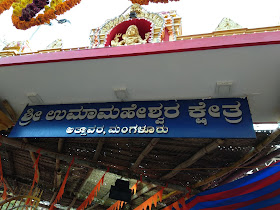Temples in India have a regular traditional system of renovation usually
in a period of twelve years and this is known as Brahma-kalasha ceremony.
Most of the temples have thus been and are being subjected to this
classical process of renovation and updating, and as a consequence, it is but natural that specific evolutionary features of historical
significance embodied in the ancient
temples since their initiation are likely to be modified or subdued. This issue
is further complicated by absence or lack of systematic preservation of
historical data relating to temples. Dr. Padur Gururaja Rao (19xx ) has made an
extensive study of idols installed in temples of Tulunadu and attempted to roughly
date them according to the characteristic sculptural features displayed .
However, still lot of further work is needed to be done to refine what has been
already contributed by Gururaja Bhat. One of the issues faced by researchers
appears to be is the lack of access to the idols. To assist genuine students of
history those in charge of these sacred renovation ceremonies may (1) provide
opportunities for gathering data directly and/or (2) provide or publish historical information
available at their disposal.
This year a number of temples in the region have undergone
Brahma-kalasha ceremonies with active participation of the devout public. The
temples of Mundkur, Palimar, Polali and Attavara (Mangaluru) have recently have
undergone the brahma-kalasha ceremonies.
 |
| Uma Maheshwara Temple (renovated) |
Uma Maheshwara
The poster advertisement put up in newspapers on the brahma-kalasha
celebration of ceremony of Uma Maheshwara temple at Attavara, Mangaluru, contained
an interesting piece of information. It reported that about 200 years ago,
while excavating for the construction of District Collectors office in
Mangaluru (near the present site of Deputy Commissioners Office) they recovered
an idol of Shiva. The idol was shifted to Attavara and was installed in a
temple dedicated to Uma-Maheshwara. It is interesting to note that the ancient coastal
village around DC office and old port/ Bunder area in Mangaluru was known as Nireshwalya (ie. Neere-Shivalaya) in old records. (The village name has almost
been obsolete and forgotten as people are calling the locality simply as “ Bundar”.) Anyway, the
piece of information suggests that the idol could be a part of the ancient
Shiva temple in the ancient Neere Shivalaya
village. Shivālaya means a temple
dedicated to Lord Shiva and Neere means the water or the tidal reach between
the village and the Arabian Sea. Thus the original idol of Shiva apparently was
reinstalled at Attavara as Uma Maheshwara as per the popularity of the deity
during the time of reinstallation. Unfortunately, we do not find any temporal
analysis or allied information on the idol in Gururaja Bhat’s famous work on
Tulunadu temples. Therefore anyone who has additional information on the issue
may kindly share it in this blog.
 |
| Uma Maheshwara Temple |
However this piece of information
may be useful for students of history as it reveals how several ancient idols and even temples might have been
shifted during the course of (unfortunately unrecorded) history. Similar local
information on Bappanadu temple, Mulki, suggests that original Bappanadu temple
was near the bank of Mulki port which is about 500 meters interior of the
present location of the temple.
Since most of the ancient temples have been updated every 12 years, as per
the prevalent custom of brahma - kalasha ceremonies, basically designed for
stabilization of temples apart from other issues, it is obvious that many of
the original aspects of historical significance might have been lost over the
years.
 |
| Sri Uma Maheshwara Temple Attavara, Mangaluru |
Sapaliga-Ganiga community
A note on the Sapaliga –Ganiga community that manages the temple at
Attavara, Mangaluru, evidently, since last two centuries appears pertinent
here. The interesting note apparently throws light on the tidbits of traditional
aspect on how the initial “ bari“ lineages were converted into castes or
communities and how the castes in turn were bifurcated into subdivisions during the past history in our country.
The temple of Uma Maheshwara at Attavara is managed by people of
Sapaliga- Ganiga community, probably since last two centuries since the idol
was brought from Nireshivalaya (near old Bunder /DC office area, Mangaluru) and
installed here.
Members of Sapaliga community are associated with temple music
activities in Tulunadu since several centuries, probably dating back to the
ancient days of Kadamba king Mayura Sharma (ca. 400 CE), who is credited with rejuvenation
of Hinduism and initiating a popular culture of temple based worship. The word “sappaliga”
means one who makes sounds (“sappala”) or the music.
The Ganigas in Tulunadu are
traditional oil extractors, known for
drawing oil from coconuts abound in the
coastal region.
The common association of Sapaligas and Ganigas especially popular in Mangaluru
and Bantwal region suggests that members of these communities shared
professions in the historical past.
Offshoot of Mogaveera community
However it is interesting to note that matrimonial alliances between members
of Sapaliga and Marakala (Mogaveera) communities are commonly accepted even
today, especially in Udupi-Karkala and northern part of Mangaluru regions.
Old people in the community used to report that during
olden days volunteers for the temple service, as Sapaligas, were drawn from the members of
Marakala/Mogaveera community during the historical period. And as a vestige of
the old custom even today matrimonial relationships continue among these
community members. It can be seen that members of these communities share
similar and common bari lineages
which are older in historical perspective than the castes proper.
R

No comments:
Post a Comment